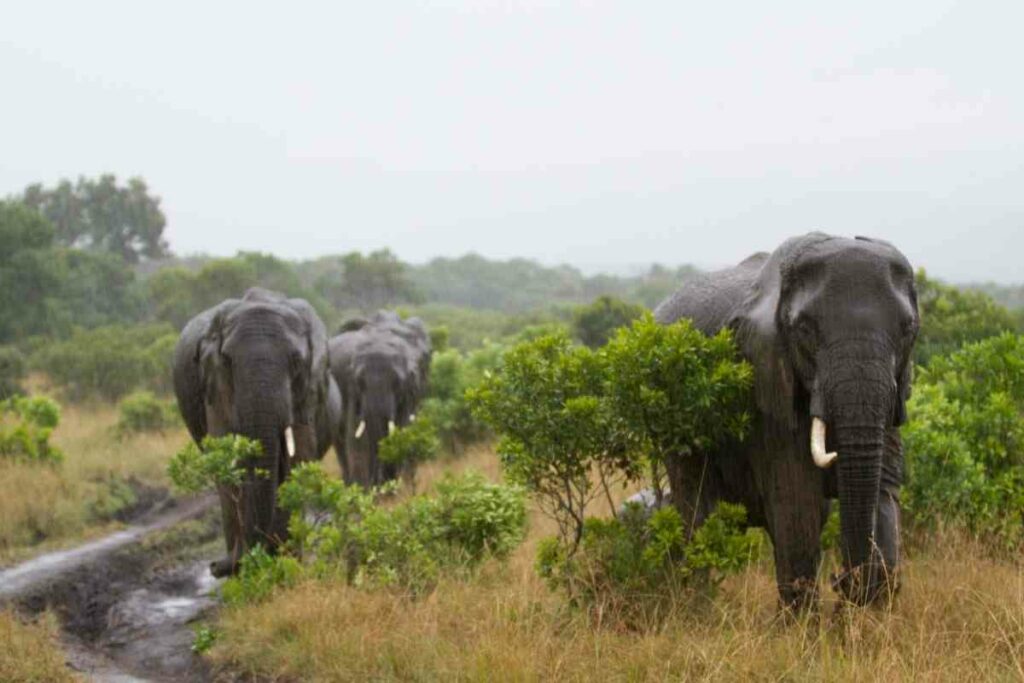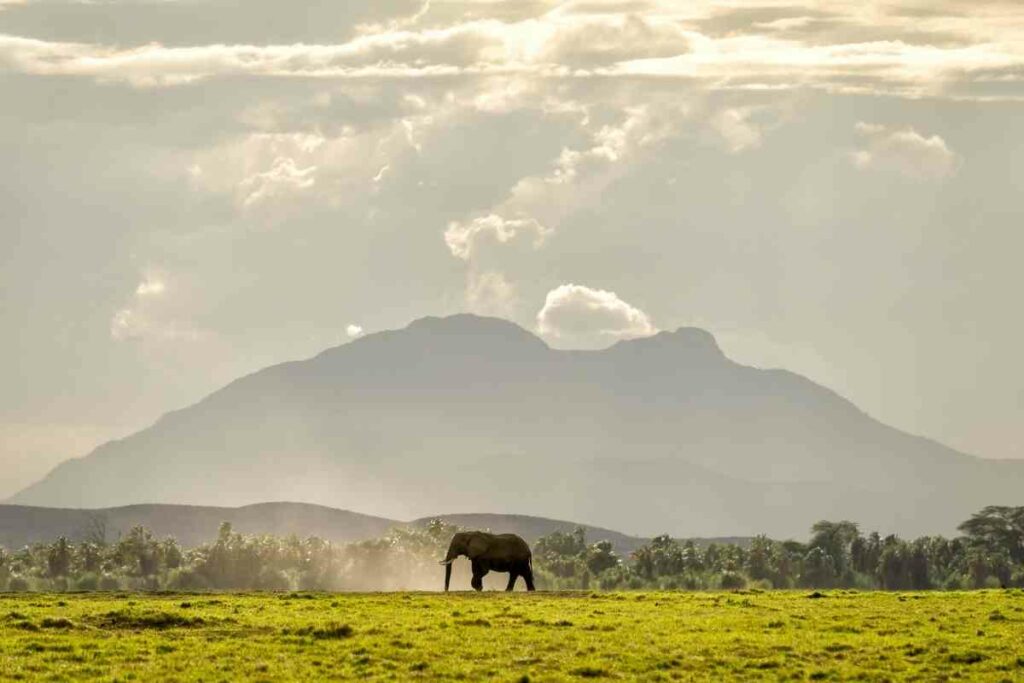The term “Big Five” was coined by trophy hunters to refer to the five largest land creatures that were notoriously challenging to subdue.
They include:
- Lions
- Elephants
- Buffaloes
- Rhinos
- Leopards
Luckily, governments have put strict measures to stop this atrocious activity, and you can now see most of them in different parks across Africa.
The Best Places to See the Big 5 Animals
When spotting the big 5 the two best countries to visit are Kenya and Tanzania.

This is because the two nations have plenty of national parks where you can view all these animals.
However, you can also opt for South Africa, Zambia, and Namibia.
Kenya
1. Maasai Mara
The best spot in Kenya to view the “big five” animals is the Maasai Mara National Reserve.
Over one million people visit this park annually, making it the most popular attraction in Kenya.

This location became well-known due to the yearly wildebeest migration that takes place there, and it attracts visitors from all over the world.
In Addition – The Maasai Mara provides good possibilities for birdwatching and is home to a wide variety of animals, including elephants, lions, and many other species.
If you want the best experience, you should visit the park between the end of June and the beginning of October.
You will not only see all the big five, but you will experience the great migration with all its glory.
That said, since it is the peak season, you can expect to pay more and deal with plenty of other tourists.

To avoid this, plan your visit at the beginning of May or at the end of October.
Lastly, the months of March through May are damp, and the lush vegetation will obstruct your view.
2. Amboseli National park
The Amboseli National Park is the second best option if you are going on a safari to Kenya.

The park is located in the southern part of Kenya and offers uninterrupted views of all the “big five” species.
Additionally, the park is fortunate to have the majestic Mount Kilimanjaro as its backdrop.
The mountain is home to a wide range of animal and bird species.
You can even take a solo drive to Amboseli at any time of the year.

This is because animals don’t follow any predictable migration pattern.
The most prolonged rains occur in April, while the shortest rainfall occurs in November and December.
Therefore, the best time to visit the park is from June to October.
3. Tsavo National Park
Tsavo consists of two distinct parks:
- Tsavo East National Park
- Tsavo West National Park
It is located between the two major Kenyan cities of Nairobi and Mombasa.

Famous wildlife includes the black rhino, Cape buffalo, elephant, leopard, hippo, and Maasai lion, and the area is also home to a wide variety of birds.
Smaller species can also be seen roaming the park, including:
- bush babies
- hartebeest
- lesser kudus
- and Maasai giraffes
The dry months of June through October and January through February are ideal for exploring Tsavo West.
However, the park is open year-round. Nonetheless, November through April and May are unsuitable for seeing the park’s abundant species.

Due to its proximity to the coast, accommodations in the two parks are plentiful.
These can be found in a wide price range; many even have a watering hole on the premises to facilitate better viewing.
Tanzania
1. Serengeti national park
The Serengeti National Park is renowned worldwide as a prime destination to see Africa’s wildlife over a vast ecosystem.

It is the oldest park in Tanzania and a World Heritage Site recognized by UNESCO.
Excellent opportunities to see animals exist throughout the year, including during the annual wildebeest migration, which is a natural wonder in and of itself.
The Great Migration isn’t the only thing that happens in the Serengeti National Park; the Big 5 of Africa can also be found there.
The best time to visit the park is during the dry months (June to October).
During This Time – There is little or no rainfall at all. The foliage is less dense, and animals are easier to observe since they congregate around water sources.
2. Ngorongoro Crater
Another great option to see the big five while in Tanzania is the Ngorongoro Crater.

After the Serengeti, it is the second most famous park in Tanzania.
The Ngorongoro is a gigantic crater formed when an extinct volcano collapsed in on itself some 25 million years ago.
It spans 260 square kilometers in area and is 610 meters deep. Climbing to the top of the crater wall offers some fantastic views.
Apart from the big five, you will likely see animals like:
- monkeys
- bushbuck
- waterbuck
- wildebeests
- gazelles
- zebras
- hyenas
- and hippos
Lastly, a soda lake teeming with birds, especially flamingos, may be found in the middle of the Ngorongoro crater.
Predators use this area as a prime hunting ground.
3. Nyerere National Park
Nyerere National Park, formerly known as Selous is Africa’s largest national park- spanning approximately 11,928 mi².

In 2019, it was declared a national park after years of advocacy.
Although the park is home to some of Africa’s highest animal populations, its vast expanse means that the park’s inhabitants are spread out widely.
This makes it not as famous as the Serengeti or the Mara.
That said, a wide variety of mammals, including lions, leopards, wild dogs, Cape buffalo, elephants, and hippos, thrive in the park.
The park is also famous for its numerous antelope species, including bushbucks, red and blue duikers, elands, hartebeests, klipspringers, oryx, and impalas.
Heads Up! The dry season (June–October) is ideal for wildlife viewing since the foliage is sparser and animals congregate around water sources.
Other Famous National Parks
1. Lower Zambezi National Park- Zambia

This is arguably one of the best national parks in Zambia, where you will most likely see all the big five animals.
The park also houses hundreds, if not thousands, of hippos, antelopes, and crocodiles that populate the riverbanks.
There is a wide variety of places to stay in Lower Zambezi National Park, from rustic tented camps to plush safari hotels.
2. Etosha National Park- Namibia

There are approximately 130 different kinds of mammals in Etosha National Park, including the big five, zebras, giraffes, hippos, hyenas, numerous monkeys and antelopes, and even the rare African wild dogs.
While game viewing is best between May and December, the rainy months of January through March are great for bird viewing.
3. Kruger National Park- South Africa
Most tourists visiting South Africa go on safari in Kruger National Park.
It features everything from mountains and rivers to savannas and tropical woodlands.

The vast plains of Kruger National Park provide excellent opportunities to see the Big Five, as well as antelopes, hyenas, wildebeests, and hippos.
The ideal time to visit the park is during the dry season (May–October). During this time, most vegetation withered and scarce, making detecting and tracking animals easier.
Final Thoughts
The Big five can be found in many National parks and game reserves in Africa.
The best time to visit most national parks is between July and October.
This is because the dry season mainly occurs during this period, forcing most animals to congregate near water sources, making them easier to spot.









